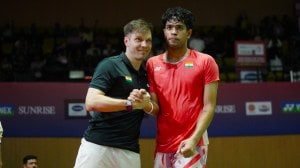Seles and Capriati meet again after emotional comebacks
NEW YORK, SEPT 6: Monica Seles and Jennifer Capriati, whose 1991 US Open semifinal seemed to herald a new era of women's tennis, meet aga...

NEW YORK, SEPT 6: Monica Seles and Jennifer Capriati, whose 1991 US Open semifinal seemed to herald a new era of women’s tennis, meet again in the fourth round here, each on the brink of a new era in their own life.
Gone are the machine gun giggles that punctuated the 17-year-old Seles’ conversation. Gone is the happy-go-lucky nonchalance with which 15-year-old Capriati regarded her precocious success.
What remains as they approach a fourth-round US Open meeting today are the stinging shots that astonished onlookers nine Opens ago.
Capriati, who was trying for a Grand Slam breakthrough after reaching the semi-finals at Wimbledon that year and at the French Open the year before, came within two points of ousting Seles before succumbing in a third-set tiebreaker. Seles went on to capture the first of back-to-back US Open crowns, defeating 34-year-old Martina Navratilova in the final.
In the intervening years, women’s tennis has been flooded with hard-hitting, outspoken teenagers, while Seles and Capriati have battled personal demons that threatened to take them out of the game forever.
“I think what it did, it brought women’s tennis to a different level,” Seles said of the 1991 match. “At that point the young girls were watching because they realized `we’ve got to hit the ball hard.’
One of those watching that match was reigning US Open champion Lindsay Davenport.
“I remember watching it from my hotel room in the city,” said Davenport, who was playing in the junior tournament that year. “It was one of the best women’s matches of all time.”
The varying obstacles each player has faced gives the rematch added poignancy, said Davenport. “Both of them have gone such different routes over the last eight years. A lot of sad stories involving both their lives.”
Seles left the game for 27 months after she was stabbed in the back by a deranged fan in 1993. In 1998 she missed two months as she chose to spend more time with her father and coach, Karolj, as he battled cancer.
His death in May of 1998 has left Seles still rebuilding her tennis life.
“It’s been a tough one for me to find people who share my same goals, because I think that’s important,” Seles said. “I didn’t get to be number one on my own. You need a support system.”
Capriati’s woes began with a so-called support system gone out of control. After turning pro at the age of 13, Capriati soared briefly, becoming the youngest ever top-10 player at 14, the youngest-ever Wimbledon semi-finalist, the Olympic champion in 1992 and the youngest player to pass one million dollars in earnings when she was 16.
But Capriati rebelled. In 1994 she was arrested for marijuana possession and shoplifting. Her sponsors disappeared. She spent time in two rehabilitation facilities.
She says she’s physically stronger and a little smarter on the court now than she was in 1991. Seles says she expects to see much the same kind of game she saw eight years ago, although perhaps a much different Capriati from the one she has faced four times in the intervening years.






- 01
- 02
- 03
- 04
- 05

























